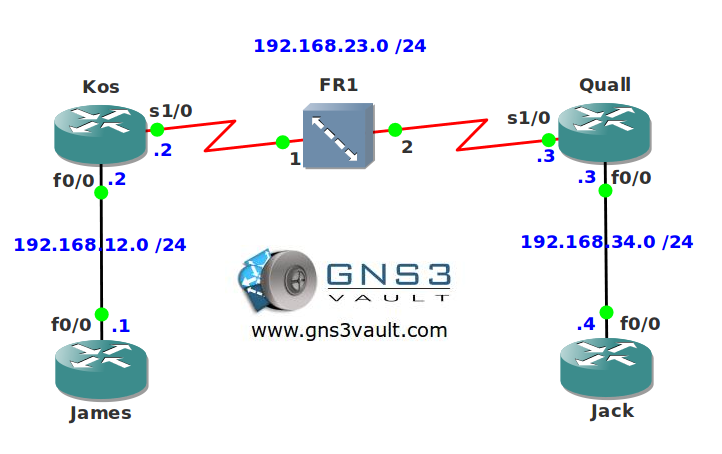Scenario:
As one of the network engineers for a large frame-relay provider in the US you are asked by your boss to configure QoS. Whenever there is congestion there is a certain amount that could be dropped from customers, it’s up to you to configure it!
Goal:
- All IP addresses have been preconfigured for you.
- Configure router Kos so there is a priority queue of 64Kbps for VoIP packets on the frame-relay link.
- Configure router Kos so you don’t exceed the CIR rate of 128Kbps when there are VoIP packets in the queue.
IOS:
c3640-jk9s-mz.124-16.bin
Topology:

Video Solution:
Configuration Files
You need to register to download the GNS3 topology file. (Registration is free!)Once you are logged in you will find the configuration files right here.

Do you want your CCNA or CCNP Certificate?
The How to Master series helps you to understand complex topics like spanning-tree, VLANs, trunks, OSPF, EIGRP, BGP and more.
Written by René Molenaar - CCIE #41726


Interesting lab. With FRTS I keep getting stuck on the heirachical policy maps. A few questions.
1. Am I right in saying that we are using MQC for the shaping, which is the reason for the config under the class-default in teh policy map?
2. Why use shape peak and now shape average?
Configure router Kos so you don’t exceed the CIR rate of 128Kbps when there are VoIP packets in the queue.
With this statement the shape peak allows us upto 256Kbps, so why not use the shape average command?
Keep up the good work, these labs are helping me with my CCIE written preparation.
[quote]Am I right in saying that we are using MQC for the shaping, which is the reason for the config under the class-default in teh policy map?[/quote]
Yes this is the MQC method of configuring shaping for frame-relay. You can also use the "legacy" method but I don’t think you have to do that anymore on the CCIE exam.
[quote]Configure router Kos so you don’t exceed the CIR rate of 128Kbps when there are VoIP packets in the queue.
With this statement the shape peak allows us upto 256Kbps, so why not use the shape average command? [/quote]
Good question, it doesn’t matter too much I think. By setting the peak rate to 256kbps you end up with a CIR of 128kbps…you could also use the average shaping command.
In the shape peak, i am configuring my CIR to 128000 bits and raise the burst bucket to 256000 bits and any traffic exceed 25600 is going to the exceed bucket that does not raise above 128000 bits. This is considered The three colors traffic shaping:
config t
class-map match-all VOIP
match dscp ef
! OR
! match protocol rtp audio
!
policy-map PRIORITY
class VOIP
priority 64
policy-map SHAPE
class class-default
shape peak 128000 256000 128000
shape adaptive 128000
service-policy PRIORITY
!
interface Serial1/0
ip address 192.168.23.2 255.255.255.0
encapsulation frame-relay
serial restart-delay 0
service-policy output SHAPE
end